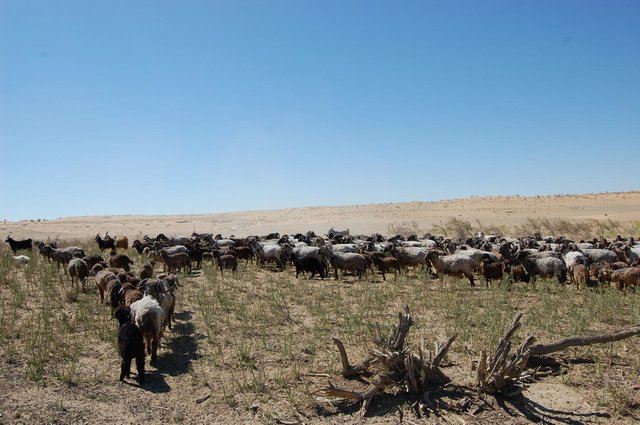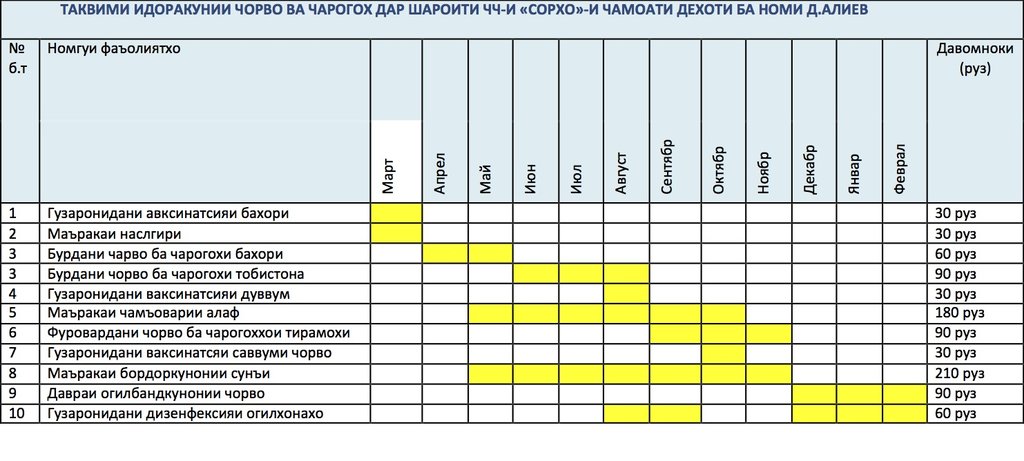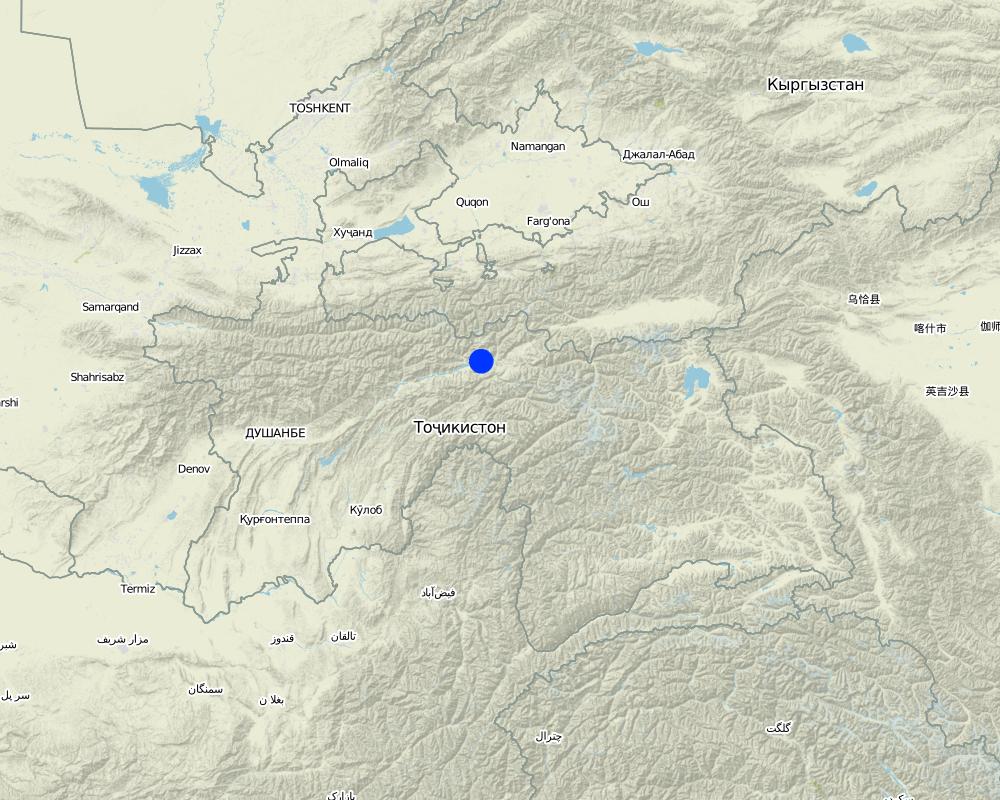Pasture Calendar [Tajikistan]
- Creation:
- Update:
- Compiler: Askarsho Zevarshoev
- Editor: –
- Reviewers: Yacime Khadraoui, Maximilian Knoll
Таквими чарогохистифодабари
approaches_3466 - Tajikistan
View sections
Expand all Collapse all1. General information
1.2 Contact details of resource persons and institutions involved in the assessment and documentation of the Approach
SLM specialist:
Name of project which facilitated the documentation/ evaluation of the Approach (if relevant)
Environmental Land Management and Rural Livelihood ProjectName of the institution(s) which facilitated the documentation/ evaluation of the Approach (if relevant)
Aga Khan Foundation (Aga Khan Foundation) - Switzerland1.3 Conditions regarding the use of data documented through WOCAT
When were the data compiled (in the field)?
20/12/2016
The compiler and key resource person(s) accept the conditions regarding the use of data documented through WOCAT:
Ja
1.4 Reference(s) to Questionnaire(s) on SLM Technologies

Ротация пастбищ в пустынных регионах Узбекистана (ИСЦАУЗР) [Uzbekistan]
Усовершенствование схемы выпаса скота, обеспечивающее восстановление пастбищной растительности и соблюдение нормативной нагрузки на пастбища.
- Compiler: Rustam Ibragimov
2. Description of the SLM Approach
2.1 Short description of the Approach
Pasture calendar services the PUU as part of the implementation of the plan with a specific timeframe and activities. It helps communities in designing intervention with regard to the need of agreed activities in the calendar.
2.2 Detailed description of the Approach
Detailed description of the Approach:
Pasture calendar is a composition of different activities and events within the PLMP of the PUU, where concrete timeframes for each events and activities are defined. PUUs were supported to develop their pasture calendar with specific activities related to pasture use and management with supervision of the PUU management. All the eight PUUs have their own pasture calendar, because the timeframes for each PUU is different. This is caused by different altitudes, that result in different timeframes for different events. For example in Jirgatal movements to the summer pastures start in May, in a lower district like Faizabad and Roghun it starts one or half a month earlier. This will help the PUUs to coordinate the livestock movement and applying different techniques in the right time. Another important element is that for each activity a responsible person or team is identified. Roles and responsibility are shared while considering gender aspects aswell. For example, specific tasks in livestock and pasture management, where women's roles are more crucial enable them to participate in planning and decision making.
2.3 Photos of the Approach
General remarks regarding photos:
The calendar format can be shaped differently depending on the community's willingness on what kind of information they want to put there. The information is agreed on with community during development of their pasture management plan, where the pasture calendar is also integral part of this plan.
2.5 Country/ region/ locations where the Approach has been applied
Country:
Tajikistan
Region/ State/ Province:
Rasht Valley/Faiobod District
Further specification of location:
sub-district of D. Aliev, PUU Sohru at sub-district level
Comments:
Coordinates of Location: Latitude - 39. 18 2: Longitude - 71 044
Map
×2.6 Dates of initiation and termination of the Approach
If precise year is not known, indicate approximate date when the Approach was initiated:
less than 10 years ago (recently)
2.7 Type of Approach
- project/ programme based
2.8 Main aims/ objectives of the Approach
The main aim of this approach is to organize activities within the given timeframe on pasture management. In this example support was provided to PUU to identify and plan the activities in a structured way for sustainable pasture management.
2.9 Conditions enabling or hindering implementation of the Technology/ Technologies applied under the Approach
availability/ access to financial resources and services
- enabling
No major financial resource is required, only the motivation of communities and PUU members is needed, however as part of the pasture planning workshop session, some resource are needed for organizing the workshop.
institutional setting
- enabling
The process is run by the legally registered institute - Pastue User Union established according to the Pasture Law.
collaboration/ coordination of actors
- enabling
Once the detailed activities on pasture use are identified collaboration with other involved stakeholders based on the analysis will take place.
legal framework (land tenure, land and water use rights)
- enabling
PUU in the framework of Pasture Law of the Republic of Tajikistan is registered.
knowledge about SLM, access to technical support
- enabling
The project staff have pasture specialists who train and build the capacity of PUU members.
3. Participation and roles of stakeholders involved
3.1 Stakeholders involved in the Approach and their roles
- local land users/ local communities
livestock owners, PUU members
active participation in the identification of main activities related to pasture management
- SLM specialists/ agricultural advisers
project specialist
provide technical support in development and design of pasture calendar
- local government
land committee, forestry department, agriculture deparment
supervise the implementation plan, support with providing advisory services also
3.2 Involvement of local land users/ local communities in the different phases of the Approach
| Involvement of local land users/ local communities | Specify who was involved and describe activities | |
|---|---|---|
| initiation/ motivation | interactive | The development of the calendar depends on the initiative of the other stakeholders. If there is no consent with others, it is possible it will not be implemented. |
| planning | interactive | It includes roles and responsibilities of different stakeholders, where an interactive approach is required for planning. |
| implementation | external support | The pasture calendar reflects the whole range of activities which are planned to implement in a given timeframe. For the implementation of some of the activities some external support both financial and technical is required, which was provided by the project staff and funding from various sources, including government and internal community fund, as well as donor fudings. |
| monitoring/ evaluation | external support | With the guidance from the project team, which also has monitoring and evaluation experts monitoring had been conducted jointly with PUUs member. In addition, the implementing agencies for the ELMARL project, such as MSDSP, have also their monitoring and evaluation departments which carried out monitoring aswell. |
3.4 Decision-making on the selection of SLM Technology/ Technologies
Specify who decided on the selection of the Technology/ Technologies to be implemented:
- mainly SLM specialists, following consultation with land users
Explain:
Project technical team, which supported the development of the pasture calendar shared expertise on the technical aspects of activities by considering local knowledge from land users and mainly decided on the selection of technology.
Specify on what basis decisions were made:
- personal experience and opinions (undocumented)
4. Technical support, capacity building, and knowledge management
4.1 Capacity building/ training
Was training provided to land users/ other stakeholders?
Ja
Specify who was trained:
- land users
- field staff/ advisers
If relevant, specify gender, age, status, ethnicity, etc.
Usually the project tried to provide gender balance in attending the trainings (50% to 50%). The main focus was on youth and women who were actively involved in taking care of livestock.
Form of training:
- public meetings
- courses
Subjects covered:
Pasture management. preparation of the pasture calendar, land management
4.2 Advisory service
Do land users have access to an advisory service?
Ja
Specify whether advisory service is provided:
- on land users' fields
Describe/ comments:
by project staff and also specialist from land and pasture committee, environmental committee
4.3 Institution strengthening (organizational development)
Have institutions been established or strengthened through the Approach?
- no
4.4 Monitoring and evaluation
Is monitoring and evaluation part of the Approach?
Nee
4.5 Research
Was research part of the Approach?
Nee
5. Financing and external material support
5.1 Annual budget for the SLM component of the Approach
Indicate the annual budget for the SLM component of the Approach in US$:
198.00
Comments (e.g. main sources of funding/ major donors):
World Bank and IFAD
5.2 Financial/ material support provided to land users
Did land users receive financial/ material support for implementing the Technology/ Technologies?
Ja
If yes, specify type(s) of support, conditions, and provider(s):
The ELMARL project financed by World Bank supported the PUUs with implementation of the pasture plan, including support with follow up on pasture calendar.
5.3 Subsidies for specific inputs (including labour)
- none
- equipment
| Specify which inputs were subsidised | To which extent | Specify subsidies |
|---|
If labour by land users was a substantial input, was it:
- voluntary
Comments:
The labour in all project was considered as contribution from the PUUs and therefore was shared voluntary.
5.4 Credit
Was credit provided under the Approach for SLM activities?
Nee
5.5 Other incentives or instruments
Were other incentives or instruments used to promote implementation of SLM Technologies?
Nee
6. Impact analysis and concluding statements
6.1 Impacts of the Approach
Did the Approach empower local land users, improve stakeholder participation?
- No
- Yes, little
- Yes, moderately
- Yes, greatly
Sets exact timeframe with activities to follow on and contributes to sustainable management of pasture resources.
the pasture calendar is developed in a participatory way, where decision is made in the same time with evidence base
Did the Approach improve knowledge and capacities of land users to implement SLM?
- No
- Yes, little
- Yes, moderately
- Yes, greatly
In time implementation of activities also motivates and contributing to implement SLM successfully.
Did the Approach improve knowledge and capacities of other stakeholders?
- No
- Yes, little
- Yes, moderately
- Yes, greatly
Various training as part of the implementation of the approach were provided to the land users to enable them in development of this approach and implementation.
Did the Approach mitigate conflicts?
- No
- Yes, little
- Yes, moderately
- Yes, greatly
When communities developed their pasture calendar, they agreed on the planned activities among each other, which mitigated conflict.
Did the Approach empower socially and economically disadvantaged groups?
- No
- Yes, little
- Yes, moderately
- Yes, greatly
Especially women and youth were involved in preparing the pasture calendar and were actively involved in decision making.
Did the Approach improve gender equality and empower women and girls?
- No
- Yes, little
- Yes, moderately
- Yes, greatly
Women were involved in preparing the pasture calendar, where most of the planned activities implementation depended on women. In this process women were actively involved in making decision with regards to those activities where they were actively involved.
6.2 Main motivation of land users to implement SLM
- reduced land degradation
contribute to rotational and seasonal use of pasture, which allows rehabilitation of degraded pasture
- reduced workload
The timeframe in the pasture calendar identified a responsible person per each activities, which shared the workload among the community members.
- rules and regulations (fines)/ enforcement
The approach sets certain rules and regulations and responsible persons to enforce implementation of the planned activities.
- environmental consciousness
Beside economic benefits, the approach also sets activities to follow on the environmental aspects of pasture management. This also raised awareness among PUUs members on ecological consciousness.
6.3 Sustainability of Approach activities
Can the land users sustain what has been implemented through the Approach (without external support)?
- uncertain
If no or uncertain, specify and comment:
Development of the pasture calendar does not guarantee full implementation of activities unless there is a sustainable mechanism for incentives in place.
6.4 Strengths/ advantages of the Approach
| Strengths/ advantages/ opportunities in the land user’s view |
|---|
| straight forward, easy understandable/and potential for replicaiton |
| Strengths/ advantages/ opportunities in the compiler’s or other key resource person’s view |
|---|
| easy development and doable/brings together all stakeholders in one room to jointly plan their activities with regards to pasture and livestock management/can be applied by communities without external support |
6.5 Weaknesses/ disadvantages of the Approach and ways of overcoming them
| Weaknesses/ disadvantages/ risks in the land user’s view | How can they be overcome? |
|---|---|
| depends on all involved stakeholders | required to strengthen collaboration between different stakeholder |
| Weaknesses/ disadvantages/ risks in the compiler’s or other key resource person’s view | How can they be overcome? |
|---|---|
| very theoretic and not easy to adjust to real implmentation and straight forward only reflects one steps | should be considered as integral part of the overall pasture and livestock management approach |
7. References and links
7.1 Methods/ sources of information
- interviews with land users
3
- interviews with SLM specialists/ experts
1
7.2 References to available publications
Title, author, year, ISBN:
Pasture and Livestock Management of Pasture Use Unions Sorhu, Faizabad District, D. Aliev sub-district, Tajikistan
Available from where? Costs?
Zevarshoev Askarsho, free of cost
7.3 Links to relevant information which is available online
Title/ description:
Secretariat of the Tajik Pasture Management Networking Platform
URL:
https://pasture.klink.asia/dms/documents
Links and modules
Expand all Collapse allLinks

Ротация пастбищ в пустынных регионах Узбекистана (ИСЦАУЗР) [Uzbekistan]
Усовершенствование схемы выпаса скота, обеспечивающее восстановление пастбищной растительности и соблюдение нормативной нагрузки на пастбища.
- Compiler: Rustam Ibragimov
Modules
No modules





